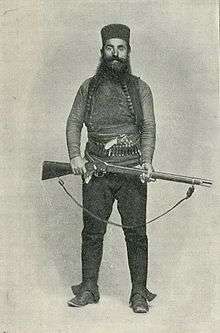Armed priests

Throughout history, armed priests or soldier priests have been recorded. Distinguished in the modern era from military chaplains who served the military or civilians as spiritual guidance (non-combatans), these priests took up arms and fought in conflicts (combatants). The term warrior priests is usually used for armed priests of the antiquity and Middle Ages, and of historical tribes.
History
In Greek mythology, the Curetes were identified as armed priests.[1] In Ancient Rome, the Salii who were armed priests carried sacred shields through the city during the March festivals.[2] Livy (59 BC–17 AD) mentions armati sacerdotes (armed priests).[3] The Aztecs had a vanguard of warrior priests who carried deity banners and made sacrifies on the battlefield.[4]
The warrior-priest was a common figure in the First Serbian Uprising (1804–13).[5] Several archpriests and priests were commanders in the uprising.[6] Serbian Orthodox monasteries sent monks to join the ranks of the Serbian Army.[5]
Legacy
The "Pyrrhic" dance in Crete is said to have been the ritual dance of armed priests.[7]
Notable groups
Notable people
- Eastern Orthodoxy
- Luka Lazarević, Serbian Orthodox priest, vojvoda (general) of the Serbian Revolution.[9]
- Nikola Smiljanić (1760–1815), Serbian Orthodox archpriest, commander in the Serbian Revolution.[10]
- Milutin Ilić, Serbian Orthodox priest, commander in the Serbian Revolution.[10]
- Matija Nenadović (1777–1854), Serbian Orthodox archpriest, commander in the Serbian Revolution.[10]
- Neofit Marković, Serbian Orthodox monk, fought in the First Serbian Uprising.[10]
- Atanasije Antonijević (1734–1804), Serbian Orthodox priest, blessed the Orašac Assembly and fought in the First Serbian Uprising.
- Melentije Nikšić (d. 1816), Serbian Orthodox priest, fought in the First and Second Serbian Uprising.
- Samuilo Jakovljević (d. 1824), Serbian Orthodox abbot, fought in the First Serbian Uprising.
- Melentije Stevanović (1766–1824), Serbian Orthodox abbot, fought in the First Serbian Uprising.
- Melentije Pavlović, Serbian Orthodox abbot, fought in the First Serbian Uprising.
- Milutin Ilić Gučanin (d. 1814), Serbian Orthodox priest, fought in the First Serbian Uprising.
- Nikola Smiljanić, Serbian Orthodox priest, fought in the First Serbian Uprising.
- Filip Petrović (1775–1820), Serbian Orthodox priest, fought in the First Serbian Uprising.
- Petar Radović (1832–1907), Serbian Orthodox priest, fought in the Herzegovina Uprising.[11]
- Mićo Ljubibratić (1839–1889), Serbian Orthodox priest, fought in the Herzegovina Uprising.[12]
- Bogdan Zimonjić (1813–1909), Serbian Orthodox priest, active during the 1852–62 and 1875–78 uprisings in Herzegovina
- Vukajlo Božović, Serbian Orthodox archpriest, fought in the Balkan Wars.[13]
- Rista K. Popović (1870–1917), Serbian Orthodox priest
- Papadrakos (1872–19XX), Greek Orthodox priest, active in the Macedonian Struggle.[14]
- Jevto Popović, Serbian Orthodox priest
- Prokopije Vujišić, Serbian Orthodox priest
- Jovan Grković-Gapon (1879–1912), Serbian Orthodox priest, guerrilla in Macedonia.
- Tasa Konević, Serbian Orthodox priest, guerrilla in Macedonia.
- Mihailo Dožić (1848–1914), Serbian Orthodox priest, guerrilla in Potarje (1875–78).
- Stevan Dimitrijević (1866–1953), Serbian Orthodox priest, guerrilla in Macedonia (fl. 1904).
- Momčilo Đujić (1907–1999), Serbian Orthodox priest, World War II Chetnik.
- Catholicism
- Aleaume de Clari (fl. 1204), Catholic priest, Crusader
- Reginald of Bar (fl. 1182–1216), Catholic bishop, Crusader
- Aubrey of Reims (fl. 1207–18), Catholic archbishop, Crusader
- Arnaud Amalric (d. 1225), Cistercian abbott, Crusader
- Bernardino de Escalante (1537–after 1605), Catholic priest
- Archbishop Turpin, legendary (insofar as military accomplishments) member of Charlemagne's Twelve Peers d. c. 800
See also
| Wikimedia Commons has media related to Armed priests. |
References
- ↑ Jürgen Trabant (2004). Vico's New Science of Ancient Signs: A Study of Sematology. Psychology Press. pp. 64–. ISBN 978-0-415-30987-5.
- ↑ Cyril Bailey (1932). Phases in the Religion of Ancient Rome. University of California Press. pp. 69–. GGKEY:RFYRJLHJJDQ.
- ↑ Roger D. Woodard (28 January 2013). Myth, Ritual, and the Warrior in Roman and Indo-European Antiquity. Cambridge University Press. pp. 73–. ISBN 978-1-107-02240-9.
- ↑ Manuel Aguilar-Moreno (2007). Handbook to Life in the Aztec World. Oxford University Press. pp. 90–. ISBN 978-0-19-533083-0.
- 1 2 Király & Rothenberg 1982, p. 275.
- ↑ Király & Rothenberg 1982, pp. 273–275.
- ↑ The Origin of Attic Comedy. CUP Archive. pp. 65–. GGKEY:QTK5DG53LT2.
- ↑ Hitomi Tonomura (1 January 1992). Community and Commerce in Late Medieval Japan: Corporate Villages of Tokuchin-ho. Stanford University Press. pp. 216–. ISBN 978-0-8047-6614-2.
- ↑ Király & Rothenberg 1982, p. 273.
- 1 2 3 4 Király & Rothenberg 1982, p. 274.
- ↑ Srejović, Gavrilović & Ćirković 1983, p. 590.
- ↑ Srejović, Gavrilović & Ćirković 1983.
- ↑ Srejović, Gavrilović & Ćirković 1983, p. 321.
- ↑ Balkanologie. 9. Balkanologie. 2005. p. 39.
Sources
- Srejović, Dragoslav; Gavrilović, Slavko; Ćirković, Sima M. (1983). Istorija srpskog naroda: knj. Od Berlinskog kongresa do Ujedinjenja 1878-1918. Srpska književna zadruga.
- Király, Béla K.; Rothenberg, Gunther E. (1982). War and Society in East Central Europe: The first Serbian uprising 1804-1813. Brooklyn College Press. ISBN 978-0-930888-15-2.